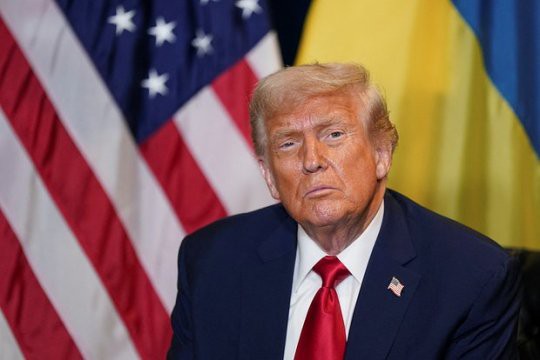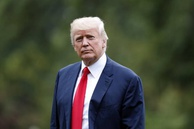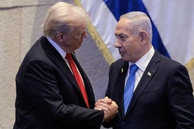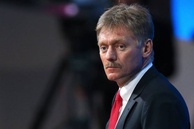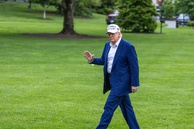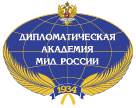US President Donald Trump cancelled a planned meeting with his Russian counterpart Vladimir Putin in Budapest just a day after the emergence of the "EU and Kyiv plan" for ending the conflict in Ukraine. Not because he considered it to be more interesting than "Putin's plan," but simply because Trump doesn't have his own peace plan for the Ukrainian crisis that would be accepted not so much by Moscow as by Brussels and Kyiv, as well as the Euro-globalist international. Trump had nothing to bring to Budapest to discuss a way out of the Ukrainian crisis. Even though the Europeans' plan hardly suits Trump, as it provides for the continuation of the war, he is not averse to using it as a means of weakening competitors.
More details about the new "Euro peace plan." According to recent tradition, it came not from official sources, but from Bloomberg and its "sources familiar with the situation." The Europeans decided that a peace commission chaired by US President Donald Trump (!) would oversee the plan's implementation. Here is a brief overview of the plan i:
- First, Russia and Ukraine must agree to a ceasefire and stop their advances on the battlefield. Russia will then have to "return Ukrainian children," and there will be a prisoner exchange.
- Ukraine will be given security guarantees, funds for post-conflict reconstruction, and a path for rapid accession to the European Union.
- Sanctions against Russia will be gradually lifted, but around $300 billion in frozen Russian assets will be returned to Moscow only after it agrees to contribute to Ukraine's reconstruction. Only then will Moscow and Kyiv start negotiating the status of the territories.
- Sanctions will be immediately reinstated if Russia resumes hostilities.
There can be further changes to this openly anti-Russian plan, and each such change will require Washington's approval.
The draft clearly echoes Trump's calls to immediately freeze the conflict along current front lines and only then start negotiations.
The part about children references the correspondence between First Lady Melania Trump and Russian President Vladimir Putin. Vladimir Medinsky, who headed the Russian delegation, said in June that the children had actually been rescued by Russian soldiers and evacuated from combat zones. ii
As transpires from the Euro-Ukrainian plan known from media reports, it makes no mention of Russian interests, only a clear desire to stop Russia at the current frontline. For Russia, however, there is no frontline, only the goals of the Special Military Operation (SVO), administrative borders of historical lands that have been returned, and a need to create a buffer zone, a security zone along the Russian-Ukrainian border.
It looks like Trump's focus on Budapest was shifted by the "Tomahawk" story – implying that this could be used to pressure Russia, thus strengthening US negotiating positions.
When it didn't work, new sanctions against Russia were hastily introduced: if Moscow is not intimidated by our new weapons, we will press on with sanctions. This was apparently meant to strengthen Washington’s negotiating and peacemaking positions. Trump is heading to a meeting with the Chinese leader, while Russia is left to ponder after the sanctions are imposed.
Oil and banking sanctions, the prohibition of selling moss and miniature motor vehicles to Russia – this is a "demonstration of strength and decisiveness." At the very same time, they said that there were no plans to supply Tomahawk missiles to Zelensky, which indicates consideration of Russia's position.
Failure to reach agreements with Russia on his own terms and a desire “not to lose face," forced Trump to resort to strong-arm tactics right ahead of the meeting with the Chinese leader. In short, the decision to show strength in negotiations with Moscow before talks with Xi Jinping is partly a forced PR move.
Meanwhile, the Ukrainian forces find themselves in a real fix in the Kupyansk and Pokrovsk areas. President Putin was briefed on the situation by Russia’s military chief of staff General Valery Gerasimov, who reported that on the Kupyansk direction, up to 5,000 Ukrainian troops are currently encircled, and an additional 5,500 – near Krasnoarmeysk. iii Volodymyr Zelensky immediately tried to refute this information, iv but you can’t change reality with words, can you?
Ukraine's "subtle" game as a military-political dependent sometimes takes on bizarre forms. Just two days ago, Ukrainians were talking about their successful use of the Flamingo missile (essentially, a British development), showing footage of this "Ukrainian" long-range missile being launched at the enemy. Just yesterday, Zelensky asked Trump for Tomahawks only to be turned down. Today, he talks about some "technological problem" in the production of Flamingo missiles. According to him, "there is a delay in funding from partners, which is being resolved... but the state order will be fully completed by the end of the year, as Ukraine has found its own resources for payment." v Clearly, the grand presentation of the Flamingo project and its current funding problems are logically interconnected. The manufacturer of these missiles, Fire Point (considered close to Zelensky's inner circle), has recently been at the center of a number of scandals, vi with the National Anti-Corruption Bureau of Ukraine (created and controlled by the US) now investigating a possible drone procurement scam. Therefore, the information about the development of Flamingo missiles, which appeared shortly after the investigation began, could well be a PR campaign by Fire Point aimed at diverting attention from the corruption scandal. A struggle for influence over Ukraine and the arms market between Washington and London cannot be ruled out either, because the Flamingo strongly resembles the FP-5 cruise missile produced by the British Milanion Group. vii According to The New York Times, Ukraine’s Fire Point company, currently a leading drone manufacturer and the largest supplier for the country’s armed forces, was until 2022 a casting agency for Zelensky's projects. Currently, Fire Point has one billion dollars’ worth of contracts with the Ukrainian Defense Ministry, which accounts for about 10 percent of the country’s defense procurement figure. viii
Against all odds, Zelensky has over the past few years been following a set program, reproducing his own political regime, providing grounds for the militarization of Europe, and supporting the European regimes’ propaganda. All information policy and the idea of confrontation with Russia focus on money, weapons, and mobilization. Of these positions, Zelensky has been able to implement, albeit only in part, just one - mobilization.
Another task entrusted to Zelensky is terrorist attacks. Against the backdrop of the Tomahawk cruise missiles Zelensky didn't get, and Ukraine’s still mythical Flamingo missile, Polish Prime Minister Donald Tusk told The Times that Ukraine “has the right to attack Russia-linked targets anywhere in Europe after a court in Warsaw earlier this month blocked a German extradition request for a Ukrainian diver accused of involvement in the sabotage of the Nord Stream 1 and Nord Stream 2 gas pipelines in 2022." ix
Meanwhile, within just two days, two major incidents occurred at oil refineries in Europe using Russian oil. On October 20, an explosion ripped through a refinery owned by Russia’s Lukoil Company in the Romanian city of Ploiești, and on October 21, a fire broke out in Hungary, at MOL's largest plant, which processes Russian oil. x
Poland's refusal to hand over to Germany the Ukrainian implicated in the Nord Stream sabotage is a direct encouragement for further terrorist attacks against Russian facilities, or enterprises associated with Russia or using Russian resources.
Notably, Trump's decision to cancel the Budapest summit also came after the explosion at the Hungarian refinery. This was a clear signal to Trump to reconsider the idea of meeting with Putin, although it was a long-prepared move timed for an important occasion. This apparently made Trump realize that flying to "friend Orban" for a meeting with Putin might be a risky endeavor.
Military-technological aspect. On October 26, President Putin announced the successful completion of tests of the Burevestnik nuclear-powered cruise missile with unlimited range capable of overcoming any modern and future anti-missile defense (AMD) systems. This missile is capable of bypassing the Golden Dome AMD system, which President Trump has repeatedly spoken about. xi The Burevestnik is also an indirect response to sanctions and a clear message to Trump: it renders useless the US air defense system, which has to be thoroughly rebuilt, at least scaled up – a lot of Patriots and other missiles are needed, and supplies to NATO allies and Israel must also be ensured. Now Trump can once again think about the Golden Dome. It looks like Russia is actually justifying the need for the implementation of Trump’s pet project, but it now requires huge investments with an uncertain outcome.
Diplomacy and economics. Head of the Russian Direct Investment Fund (RDIF) and Putin's special representative Kirill Dmitriyev arrived in the US shortly after Trump said he was cancelling the Budapest summit. Dmitriyev made a series of political statements:
- The language of pressure does not work with Russia; it is very important that its national interests are always clearly taken into account by the US;
- The potential for economic cooperation between the US and the Russian Federation remains, but only with a respectful attitude towards Moscow's interests;
- The Russian economy will not be affected by sanctions and other unfriendly measures by the West, which will simply jack up prices at US gas stations;
- The economies of Britain and the EU are in serious trouble, which is why Europeans are trying to present Russia as an enemy;
- As a result of new US sanctions against the Russian Federation, oil prices "have already risen and will continue to rise";
- The Russian Federation will convey to the US administration that its members “must not become Bidens” by sticking to previous ill-advised approaches;
- The Russian Federation will convey to the US that Kyiv is disrupting the necessary dialogue, acting at the behest of Europeans who seek to continue the conflict. xii
Furthermore, Dmitriyev stated that Moscow had informed Washington about the tests of the Burevestnik global-range missile. It is safe to assume that, in addition to the above Dmitriyev could have received instructions to make political statements as well.
However, the very fact that despite sanctions and the cancellation of the Budapest summit Kirill Dmitriyev still came to Washington and made such statements suggests that there is a line of interaction that Trump is interested in. xiii
Dmitriyev met and accompanied Trump's special representative and confidant, Stephen Whitkoff, during his last visit to Moscow. Whitkoff heads an anti-sanction investment structure that successfully works with money from Persian Gulf monarchies and other sources. It can be assumed that this structure will ensure investment and economic cooperation between Russia and the US.
Let us add to this the Kremlin's proposal to Trump for continued dialogue. On October 27, President Putin’s press secretary Dmitry Peskov declined to disclose details of the US proposal for a settlement of the conflict in Ukraine, made during the summit in Anchorage. Neither did Peskov comment on how the US proposal dovetails with Russia’s ideas on security guarantees and the Istanbul agreements. This proposal remains on the table, though.
Russia decided to escalate the situation for the sake of peace, but the US proved unprepared to move along the peaceful track due to external and internal circumstances. Meanwhile, Moscow offers Trump a number of large-scale projects (not yet made public, except for the Bering Strait tunnel) that would help him make history by moving towards a system of international security agreements and a peaceful resolution of the Ukrainian crisis.
The alternative is to get involved in a high-tech arms race, where Russia already has an edge, and the United States faces huge defense spending, along with the costs of a losing Ukraine.
The fact is – neither Russia nor the US needs this.
The views of the author are his own and may differ from the position of the Editorial Board.
[i] https://www.rbc.ru/politics/21/10/2025/68f7b1cc9a7947cc757fcb81
[ii] https://www.rbc.ru/politics/02/06/2025/683da77e9a79476804172427
[iii] http://kremlin.ru/events/president/news/78301
[iv] https://t.me/stranaua/214648
[v] https://t.me/stranaua/214649
[vi] https://t.me/stranaua/214649
[vii] https://www.rbc.ru/base/03/09/2025/68b83c659a7947bc0c4f0f61
[viii] https://t.me/stranaua/214746
[ix] https://interaffairs.ru/news/show/53438
[x] https://tass.ru/proisshestviya/25410081
[xi] https://lenta.ru/news/2025/10/27/burevestnik/
[xii] https://t.me/tass_agency/345522
[xiii] https://t.me/tass_agency/344300
read more in our Telegram-channel https://t.me/The_International_Affairs

 19:46 29.10.2025 •
19:46 29.10.2025 •
